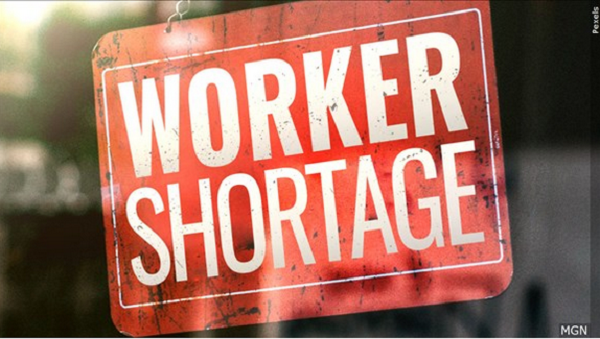
Story Summary
- Businesses are scaling back offerings and simplifying services to keep operating efficiently with fewer staff.
- Before COVID, companies spent decades expanding their variety of products to boost revenue and appeal to every taste.
- Supply troubles are likely to ease, but labor gaps could persist.
Good Stuff Eatery, a Washington, D.C.-based hamburger chain, never thought twice about filling out its menu with dishes outside its specialty.
But with labor shortages limiting staff to about half its pre-pandemic level, Good Stuff finally made some tough choices a few months ago.
Gone are the portabello sandwich, tuna melt and ice cream sundae.
“Before, we were so busy it didn’t matter,” says Micheline Mendelsohn, Deputy CEO of Sunnyside Restaurant Group, which owns the chain. Now, she says, managers are asking questions like, “Do enough people order tuna at a hamburger restaurant” to justify the time and cost?
As nationwide worker shortages drag on, many businesses are scaling back their offerings and simplifying products and services so they can continue to operate efficiently with fewer employees. Restaurants are slimming down menus. Hotels and casinos are paring back housekeeping services, breakfast bars and live events. Big-box stores are slashing the number of items they carry.
QUITTING TIME: The number of people leaving jobs hit an all-time high in November as openings stayed near record
FED FACES CRUCIAL TEST: Any interest rate missteps could tip economy into recession

Companies are reducing or simplifying product offerings to better cope with the labor shortage. SDI PRODUCTIONS / GETTY IMAGES
“People are asking are there ways to simplify what they offer to reduce the amount of labor they need?” says Bryan Hancock, global leader of talent work for consulting firm McKinsey.
Before the pandemic, companies spent decades expanding the variety of products they offered to boost revenue and appeal to every taste. The average supermarket stocked about 35,000 separate items pre-health crisis. But at the end of last year, that total was down 7.1%, according to NielsenIQ.
McDonald’s, Nestle, Pepsi cut back
Companies like McDonald’s, Denny’s, Nestle and PepsiCo streamlined their offerings early in the pandemic to better cope with supply chain bottlenecks and fewer customers, as well as worker shortages. Executives said many of the ditched products won’t be coming back, even after the health crisis and supply snags fade.
Although supply troubles are likely to ease by the second half of the year, the labor gaps are expected to persist, says economist Dante DeAntonio of Moody’s Analytics. Many restaurant and hotel employees have permanently left the hospitality industry. And as many as 2.4 million Americans retired early during the crisis, according to the Federal Reserve Bank of St. Louis. The vast majority aren’t likely to return.
That gives U.S. corporations another reason to stick with their streamlined offerings.
Olive Garden limits menu
Darden Restaurants, owner of Olive Garden, LongHorn Steakhouse and other chains has said it’s mostly keeping the less elaborate menus it began during the pandemic, which have trimmed food preparation and expenses.
“It would be fair to say that all the work we’ve been doing to simplify our business, including during the height of the pandemic… has helped us deal with the staffing challenges better than most,” says Darden spokesman Rich Jeffers.
While toilet paper demand surged early in the pandemic, Georgia-Pacific stopped producing 164-sheet rolls to focus exclusively on 328-sheet rolls to increase efficiency.
Now, “We have continued to limit the number of items we produce to proactively address labor and carrier shortages that both Georgia-Pacific and our customers are facing,” the company said in a statement.
Simplicity may mean better jobs
A slimmed-down strategy also allows businesses to be more productive while attracting workers with more straightforward jobs that come with fewer headaches and shorter hours, says Sarah Kalloch, executive director of the Good Jobs Institute, which helps companies create good jobs.
Some consumers may be irked that their favorite entrée or potato chip brand may not be available. But many others appreciate a less dizzying array of choices, Kalloch says.
The shrunken labor force has also given workers unprecedented leverage. In December, there were 10.9 million job openings and 4.3 million workers quit, typically to take new positions, both near-record levels, the Labor Department said this week. Labor on Friday unexpectedly reported a booming 467,000 job gains in January despite COVID-19’s omicron spike, which kept millions of people out of work.
The coronavirus omicron variant wave is expected to peter out within weeks, but hiring struggles are likely to continue. Forty-nine percent of small-business owners said they had jobs they couldn’t fill, near an all-time high, in December, according to the National Federation of Independent Business, a trade group for small businesses.
Many small- to midsize firms are winnowing their products and services to align workloads with skimpier staff.
Good Stuff Eatery decided to scrap the portabello sandwich because it’s so labor-intensive, Mendelsohn says. Mushrooms must be roasted and stuffed with cheese while a special sauce is added, she says.
Yet the restaurant has just one prep person, down from three before the pandemic, making the task more challenging. Meanwhile, she says, “People aren’t coming in as much…There’s just not as much profit.”
Instead of the portabello sandwich, she says, the eatery is adding fried green tomatoes, which requires less prep time. Executives are also scrutinizing all menu items.
“If you have 30 things on the menu but 10 sold the most, you have to have more customers” to justify the less popular items.
She doesn’t foresee most dropped menu items returning. Even if the pandemic eases later this year, she expects people to dine out less frequently than they did pre-COVID-19 even as the labor pool remains smaller.
“(Workers) are not there anymore,” she says. “Restaurant work is hard.”
‘Tired of the labor challenges’
Neema Hospitality, which owns a dozen hotel franchises in the mid-Atlantic region, typically acquires one or two a year, says company president Sandeep Thakrar.
But now, he says, he’s looking exclusively for extended-stay hotels, which require smaller staffs because rooms have to be cleaned just weekly and there’s typically no pool, breakfast bar, or meeting rooms.
Noting he’s perennially struggling to hire workers, especially housekeepers, he says, “I’m so tired of the labor challenges.”

Sandeep Thakrar, president of Neema Hospitality HANDOUT
Thakrar may partner with a company to buy extended-stay franchises or snap up traditional limited-service hotels and upgrade them with kitchens. An extended-stay hotel typically employs about 10 workers, compared with 15 to 20 for a limited-service hotel, he says.
“I’m more confident that the worker shortage is something we’re going to have to live with,” Thakrar says.
Fewer concerts
Other hotels are taking aim at bigger frills. The Lucky Eagle Casino & Hotel in Rochester, Washington, which is owned by the Chehalis Tribe, sharply reduced its concerts last year to improve employees’ jobs and not overburden limited staff.
Workers had to set up chairs in a multipurpose room not built for concerts, coordinate with security and sell tickets, says hotel director Ben Scholl.
“It made team members’ jobs harder and more complex,” Scholl says, noting the company is in the lodging and gaming business. “It’s not our core function.”
It also increased their stress and workloads, says company CEO JaNessa Bumgarner.
Since Lucky Eagle cut back on the concerts and simplified jobs in other ways, the company has reduced employee turnover. About 10% of the hotel and casino’s 500 or so jobs are vacant, down from about 25% in the spring, Bumgarner says.
The Good Jobs Initiative has made its mission working with businesses like Lucky Eagle to streamline jobs, in part, to cope with the labor shortages.
A few years ago, Sam’s Club shaved the number of items it carried by 20%. Simpler offerings meant less training, Kalloch of Good Jobs says. Restocking shelves was faster and workers became more productive and made fewer mistakes, leading to higher wages. Shifts were more predictable, allowing for consistent schedules and lower employee turnover.
“We have to make operations less complex,” Kalloch says. “Everybody’s better able to execute; there’s cost savings.”
What do consumers want?
Krishnakumar Davey, president of client engagement for IRI Worldwide, a retail and consumer products analytics firm, suggests that when the health crisis and labor shortages ease, companies will return to greater product varieties.
“We’re all looking for that new thing, that shiny penny,” Davey says, adding that new offerings also help firms stand out from competitors.
But Kalloch disagrees, saying consumers are fatigued by too much variety.
“You’d think customers would miss choice,” she says. “But they want quality and they want to know what to expect.
“If a company doesn’t know what their customers want, they end up throwing everything but the kitchen sink at them.”